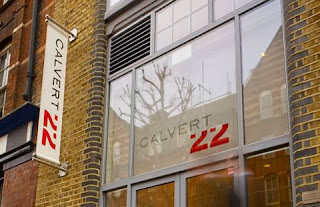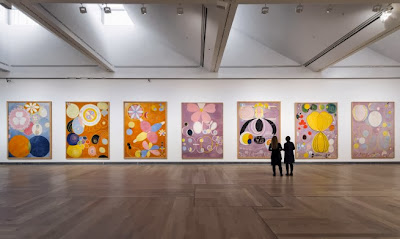Today I went with my Territory of Practise group to visit Calvert 22 Gallery/Foundation in the East End to view the exhibition Dear Art curated by 4 women which had a definitive political theme. I have never been around in this particular area and I was surprised to find how funky, arty the area was with galleries cafes I mean really trendy.
Calvert 22 Gallery is a non profit Foundation that promotes Russian & Eastern European Contemporary Art thought in the exhibition there where two Italian Artist Rossella Biscotti (her surname means biscuits) & Cesare Pitroiusti. The space inside was minimalist modern with a red wooden table, bench and there blocks surrounded by books, magazines on Russian and Eastern European conceptual artist and a mini bar inside the gallery one could sit and I also noticed the stuff was allowed to sit as well (in a lot of galleries this is not possible) which I thought was good they have a downstairs space as well where there was a film on show. The artists in the exhibition show different ways of dealing with political activism some are up front others more subtle in their approach but they have in common the fact that political issues, activism and show that it can be explored in different ways and still engage the audience.
I watched the video titled The Emperor is Naked 2013 by artist Marina Naprushkina from Belarus who now lives in Berlin.
In the video one can see her running through the snow while she speaks about becoming politically active in her art work after some of her family, friends where persecuted in Belarus so she was explaining how can a piece of political engaged art work can bring change in a country where they don't have democracy and civil rights ( her words). In the video she also says that for her it's better to be politically active in the street then on the Internet as it is less dangerous and more personal. She was explaining that on the street one can discuss with people who stop to chat to her about her ideas/cause and she can bring change in the way they think in a more direct way ( she is shown in the video holding a piece of art board like one would do in a protest. In the video she also talks about capitalism and how Germany is been benefiting in being competitive within the Euro zone and failed to have more outright Utopian ideal of living then brought into practise which I thought was unfair as one can not blame the Germans for being more efficient then others in the European Union there are other countries and if they are in the EU is because the governments of each Eu country feels that's the right choice ( I don't agree with this I think the EU is a mess) and if they don't oppose to legislation's put forward by Germany they then can not blame all of it on Germany each EU country should take responsibility for their own situation at the same time the undemocratic way the EU has been set up will eventually bring it to it's own collapse. Anyway the art work by Marina Naprushkina is thought provoking and it makes you think about the role of art and of the artist within society and how one can be politically active in an artistic way: in a positive way and bring change in the way of thinking and within society so in her art work art is used a means to change and it's thought provoking.
Then there is the work of Turkish artist Halil Altindere three hand made gold necklaces with in scripted 'I 'd rather have roses on my table than diamonds' on my neck then the second necklace is got unscripted 'If I can't dance it's not my revolution' and in the third necklace my favourite it said: 'Women need not always to keep their mouths shut and their wombs open' which are about women's right, freedoms their right for self determination and she focuses your attention on the actual words by the statement being funny & true so in her work written words contain a political message. Apparently the proverbs in her necklaces have been taken from sentences by a pioneer peace activist and anarchist and a feminist so by famous public figures.
While the artwork 'Bread and Cake' is a more subtle way of dealing with the political. Mladen Stilinovic from Belgrade by associating bread with cake is relating two different class systems the poor and the wealthy so the work is about the class systems and also implies labour, the relationship between power the people at the top and the once at the bottom. Another artist that is less direct in the way he presents political ideas is the German artist Lutz Kruger who made a video about the 1938 suicide of german painter Ernst Ludwig Kirchner this is one of his painting titled 'Marzella'.
Kirchner was an Expressionist painter considered degenerated by the Nazis his works where destroyed by them if you weren't aware of Kirchner history, the period he lived in & the kind of art he was making the video wouldn't make much sense. Kruger videos his friend who is supposed to represent the painter Kirchner walking in the mountains and shooting himself again again which to me represents the ultimate annihilation of the individual against the authority in power.
After watching the video I went back to check the work 'Bread & Cake' and I asked the gallery attendant if the bread and cake where changed daily? As it looked fairly fresh it would be interesting to go back in a while to see how well is keeping but he said they don't change it daily like for example in Sarah Lucas work. Then I move on to Sanja Ivekovic's artistic work which deals with issues of gender and politics in the media and in society. They are large photos of images (you can't missed them) of what appear to be women in glossy magazines till one realises they actually feature the feminist activist Jana Sarinic practising the gesture of the partisan salute.
Finally below the work of Cesare Pitroiusti: drawings on paper & Slovenian dark beer so not any beer but Slovenian! His work is about limitation of property and he seems to be concerned with the political but in terms of economics & what is art worth and he is interested in the relationship of ordinary acts.



































